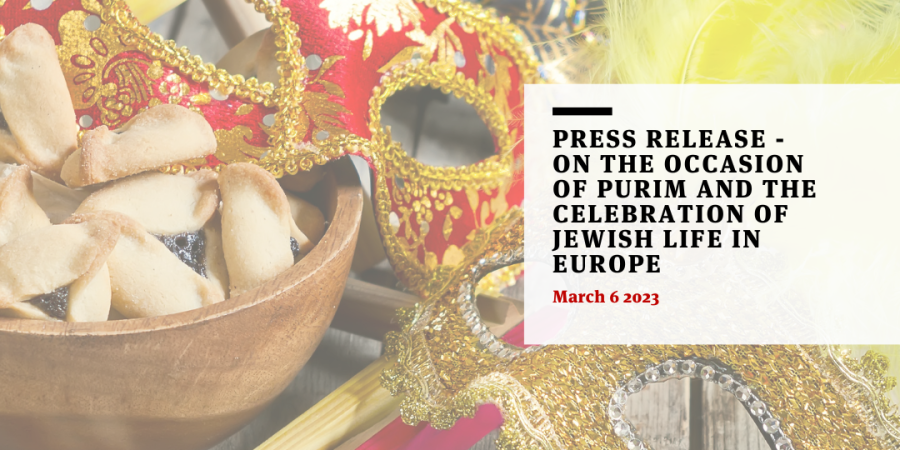
Press Release - On the occasion of Purim 2023 and the celebration of Jewish life in Europe
Between March 6th and 7th, Jewish communities across Europe celebrate Purim. Even though this joyous holiday might, at first sight, resemble the spring carnival with party-goers dressing up, its origins are deeply rooted in the history of resilience, perseverance, and survival of the Jewish people in the face of existential threat. Purim is traditionally explained to be based on a biblical story from the 5th century BCE, in which a young Jewish woman Esther, married to the then-Persian emperor Ahasuerus, saves her people after hearing of the genocidal plan by Haman, one of the emperor's officials to “...destroy, kill and annihilate all the Jews, young and old, infants and women, in a single day.” The reason behind his wrath was his allegations against the Jewish subjects of Persia of having double loyalties and not abiding by the laws after Esther’s cousin Mordecai had, due to religious reasons, refused to prostrate in front of him. By pleading with her husband and revealing her so-far-hidden Jewish background, Esther convinces the emperor to stop the massacre.
In our present-day context, Purim and its background remind us of the importance of the fight against hate crime and discrimination targeting Jewish communities, individuals, and people perceived as such and of joint efforts in European societies to foster Jewish life. The European Commission has called combating antisemitism a shared responsibility of the EU institutions, the Member States, local Jewish organisations and communities, and human rights and civil society actors.
Around 100 actions to achieve this were put together in the EU Strategy on combating antisemitism and fostering Jewish life, which the EC adopted in October 2021. National action plans against antisemitism, adopted in 14 Member States and under development in further 8, are necessary to give the work an institutional frame.
However, this work cannot be realised without the help of local governments. Between the national authorities and the civil society are cities and municipalities. Through their local policies and initiatives, they can ensure that the Jewish communities are given the necessary political, financial, and moral support to bring out their full civic potential. Thus, while in the biblical story, Haman did not tolerate religious or cultural diversity and accused the Jewish subjects of “keeping themselves separate,” European local authorities should create cities where Jewish citizens should feel safe living by their own beliefs and expressing their own religious identities.
By giving Jewish identities their full recognition, allowing space for diversity in all areas of life, acknowledging the value of Jewish contribution to cultural life, ensuring security for places of worship, fighting against discrimination, and safeguarding freedom of belief as a fundamental human right, cities and municipalities can create structures and practices that promote social cohesion. Antisemitism is not a phenomenon that has been born and lives further in a vacuum. As Rabbi Jonathan Sacks noted in a speech at the European Parliament on 27 September 2016, “The hate that begins with Jews never ends with Jews. We make a great mistake if we think antisemitism is a threat only to Jews. It is a threat, first and foremost, to Europe and to the freedoms it took centuries to achieve.” Thus, in the long run, the actions taken by local governments will benefit not only the Jewish community but everyone, as these freedoms form the basis for societies of any forms of racism and discrimination.
